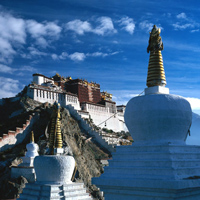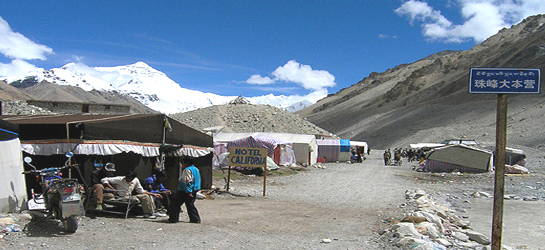Shigatse
Shigatse Overview
-
Adventure tour
Located in the south of Tibet, with Lhasa in its east and the Himalaya mountain range to its South, Shigatse is the second largest city. It sits at an average elevation of 3,800 meters. As an ancient city, it has a history of nearly 600 years and its Tibetan name, Xikasangzhuz and Xikazi for short, which stands for ‘a manor of the most fertile soil’.
Highlights:- The most colorful area in Tibet with vast grasslands, fertile fields in river valleys, flourishing semitropical jungles and snowfields at high altitudes.
- The famous scenery spots include Xiqin Spring, Yatung Spring, Yongzelucuo Lake, Tashilumpo Monastery, Palkor Monastery in Gyantse, Sakya Monastery, Pingcuolin Monastery, Juenang Monastery, Pala Manor and etc.
- The distinct style of variable festivals: Annual Zhanfo Festival and Tiaoshen Festival in Tashilumpo Monastery, Ximuqinbo Festival in Xialu Monastery and Tibetan drama shows.
- Rich medicine resources, among which there are more than 300 kinds of medicines for common use, such as aweto, fritillaria, gastrodia tuber, hsueh-lien-hua, rhodiola root and rhubarb.
Best time to visit
-
The best time to visit Tibet is from April to October, avoiding the coldest months during the year. However, most rainfall also comes during this season between June and September.
How to get there?
-
Beijing to Lhasa about 4064KM
Shanghai to Lhasa about 4373KMPlane and Train information (return)
Plane:
Beijing to Lhasa
CZ3183 (07:50-13:30) or CA4112 (08:55-14:40)
Lhasa to Beijing
CZ3184 (14:40-20:30) or CA4111 (15:55-21:30)Shanghai Pudong to Lhasa
MU2335(08:10-15:20)
Lhasa to Shanghai Pudong
MU2336(16:10-22:40)Train:
Beijing to Lhasa T27(21:30-20:20) 46.5 hours
Lhasa to Beijing T28(08:30-07:34) 47 hours.Shanghai to Lhasa T164 (20:08-21:00) 48 hours and 52 minutes
Lhasa to Shanghai T166 (10:00-10:58) 48 hours and 52 minutesTrain tickets are very difficult to purchase. Tickets are released for sale very close to the departure date and are very popular.
Traveling time between major cities and road conditions
Lhasa—Tsetang 200KM City roads 3 hours
Tsetang—Gyantse 330KM City roads 4.5 hours
Gyantse—Shigatse 90KM City roads 1.5 hours
Shigatse—Lhasa 260KM City roads 4 hours
What to see
-
In the Gang Gyen Carpet Factory local women produce beautiful carpets, and even without buying anything it’s a great experience to see the process of this famous handicraft.
The Night Market is a small cluster of street food stalls, where you can enjoy traditional food and nice atmosphere.
The Dzong Palace once resembled a small Potala, but was destroyed during the war in 1959. Only little remains can be found today but nevertheless it is a good spot to take in the view over the town.
Next to a traditionally Tibetan neighborhood of narrow lanes and tall whitewashed walls is the Tibetan Market, selling souvenirs, such as prayer wheels and incense, and a few Tibetan necessities – medicine, legs of lamb and large knifes.
Tashilunpo Monastery was founded in 1447 by Genden Drup, the first Dalai Lama. Since 1642 it has been the seat of the Panchen Lamas, who are second in authority to the Dalai Lama. It is a huge monastic compound of golden-roofed venerable buildings and cobbled lanes and it would take days to explore it fully.
At its peak the monastery housed around 4.700 monks. It's golden roofs and red walls glitter under the sunlight and the sight is supposed to bring peace to your soul.The New Palace of Panchen is situated to the south of the Tashilhunpo Monastery. The imposing and elegant palace is the best place for Panchen Lamas to stay out of the summer heat. The grassy plot nearby is a most interesting and busy place during holidays. It majestically blends both traditional and modern architectural styles. Green plants cover the palace, creating a natural and peaceful environment. The palace houses a number of precious cultural relics including spectacular frescos. The most famous fresco is 'Phakpa Meeting Kublai Khan', depicting Lama Chogyal Phakpa (1235-1280 AD) joining the court of Kublai Khan (1215-1294 AD) as imperial spiritual teacher.
The Shalu Monastery was built in 1084 in a quiet village, the monastery is a mix of Tibetan and Han styles, simple and pure. As the earliest monastery of the Shalu Sect, the ancient murals well preserved inside are deeply appreciated. It is also one of the most distinctive among a great number of monasteries of the Gelugpa Sect (Yellow Sect).
Useful Information
-
High altitude awareness
Because of its high altitude, the air pressure there is quite low. Consequently Mountain Sickness (altitude sickness) may be a problem for many visitors. Taking effective medicines and more breaks during your sightseeing trips will help.What to bring
Sunglasses, a good sun block, and a hat to protect yourself from the sun's harmful rays is another handy thing to take with you on your tour.The temperature difference between the daytime and nighttime is extreme. During the day, especially at noon, the high temperature may cause sunstroke while the low temperature at night may contribute to people catching colds. Accordingly, warm and windproof clothes are highly recommended.
More Information
-
Festivals
Tsang New Year December 28-29 (Tibetan Calendar)
On the first day of October, Tibetan Calendar, people will celebrate the Tsang New Year. Men cut branches of willow tree and sew colorful prayer flags on them; blue flag on the top to indicate the sky, white flag beneath represents the cloud, red flag symbolizing the fire, green one emblematizing the water, and yellow one standing for the earth. The branches will be hung on the hill and the river nearby the village and the four corners on one's own roof. In that case, people believe the gods of hill, river and family will protect and bless them.Buddhist exhibition festival
Every year, the Tashilhunpo Monastery unfolds and displays the giant Thangka of Buddha on the 14 th , 15 th and 16 th of May, Tibetan calendar.Bathing Festival
The Bathing Festival usually falls on the first ten days of July according to Tibetan calendar, and lasts a week. According to Tibetan Buddhism, the water in Tibet at this time has eight advantages: sweet, cool, soft, light, clear, clean and safe to the throat and belly. At this time, the river water has a relatively high temperature and is suitable for bathing. During the seven days, tens of thousands of Tibetan men and women go to river or lake to have baths. The tents, big or small, dot the beach and Lingka and transform the environment into a very colourful world.Shopping
The gold, silver and copper wares in Shigatse are very famous. Carpet is another popular feature of Shigatse. Tibitan colorful carpets and rugs are considered to be among the Three Famous Carpets in the world.Food
Sausage、Highland barley wine、Yak butter tea、Tsam-pa、milk tea、and yoghurt are very popularMinorities
Most of the people who live in Shigatse are Tibetans, however you can find Han people, Hui, Naxi, Miao, Bai ,Zhuang, Manchu and Mongolians as well.


 7 Days Tibet (Lhasa, Tsetang, Shigatse)
7 Days Tibet (Lhasa, Tsetang, Shigatse) 5-Day Essential Tibet
5-Day Essential Tibet Overland Through Tibet To Mount Everest
Overland Through Tibet To Mount Everest



